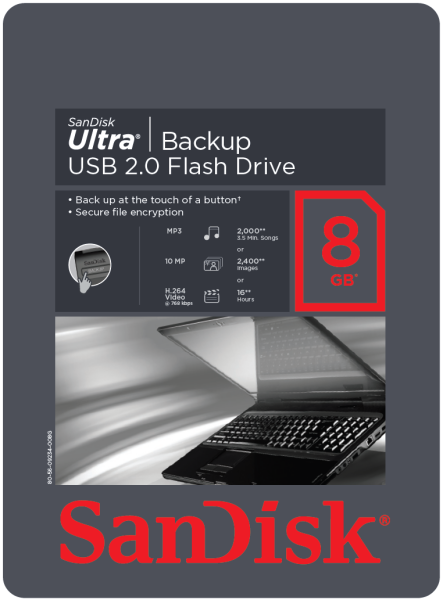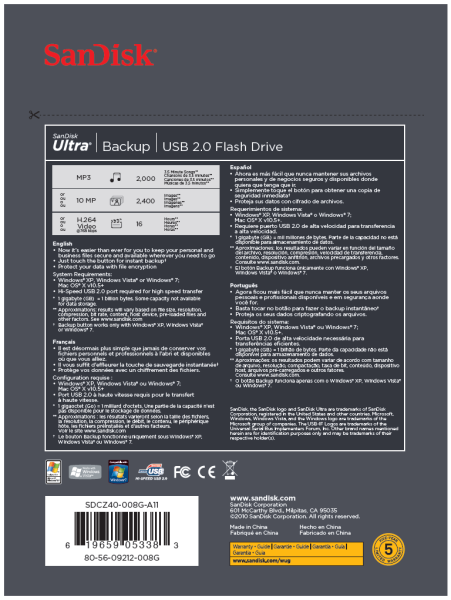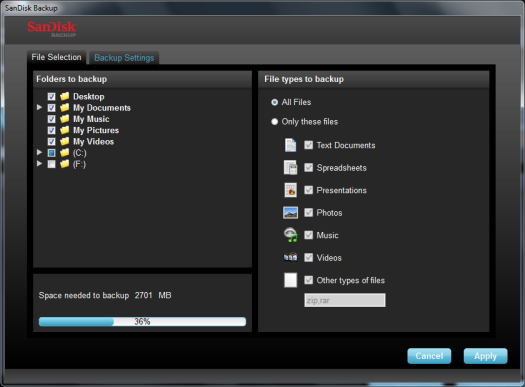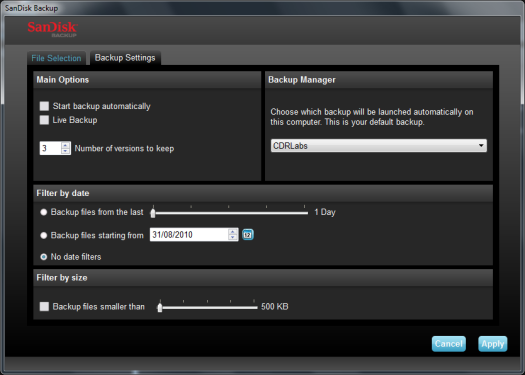

Model: SanDisk Ultra Backup
Manufacturer: SanDisk
Provided By: SanDisk
SanDisk has been a leader in the storage industry for more than 20 years. Founded in 1988 by Dr. Eli Harari, the company has grown to become the world's largest supplier of flash memory data storage products. The company offers a wide range of products including memory cards, USB flash drives, SSDs and its popular line of Sansa music and video players.
While the market is already full of backup solutions from various vendors, this hasn't stopped SanDisk from introducing their own. At the 2009 Consumer Electronics Show, SanDisk unveiled the Ultra Backup. The first of its kind, this innovative USB flash drive offers simple backup at the touch of a button. No cables are required and with SanDisk's U3 platform on board, there is no need to install any software. Just plug it in, push the button and your photos, videos and documents are automatically copied onto the drive. Once on the Ultra Backup, your files are kept safe using both password protection and AES hardware encryption.
SanDisk is now in the process of releasing an updated version of the Ultra Backup. While the drive itself hasn't changed much, if at all, the backup software has been given a major overhaul. SanDisk has dropped support for their U3 platform in favor of a more traditional software solution. This may be a good or bad thing, depending on your experiences with U3. However, the Ultra Backup now offers improved support for Windows 7 and, for the first time, Mac OS X.
Packaging:
The Ultra Backup we received from SanDisk was an early sample and did not come in retail packaging. The company was able to provide a few images showing what the new packaging will look like when it shows up in stores.
Physical Features:
The Ultra Backup is one of the larger flash drives in SanDisk's lineup. Measuring 2.87" long, 0.87" wide and 0.42" thick, its about the size of a pocketknife or disposable lighter. While you probably wouldn't want the drive hanging off of your keychain, it easily fits in a pocket, purse or laptop bag.
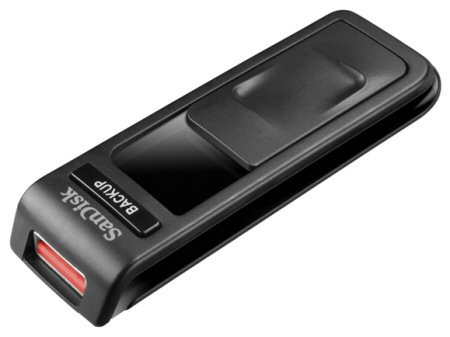
The body of the Ultra Backup is constructed of a lightweight, black plastic. The drive's bright red USB connector is exposed using a unique sliding mechanism which can be manipulated with just your thumb. The Ultra Backup also has a glowing, amber-colored LED which pulses rapidly when data is being transferred and slows down when the drive is idle.

The Ultra Backup's most unique feature is its "backup" button. When pressed, this button tells the software on the computer to start the backup process and copy your files onto the drive.
Installation:
As with most USB flash drives, the Ultra Backup was very easy to install. Those running Windows 2000, XP, Vista or 7 can simply plug the drive into any available USB port on their computer. If the computer is already turned on, plug and play will automatically detect the drive.

If installed correctly, the Ultra Backup should show up in the Device Manager. Under Windows 7, the drive is identified as a "SanDisk Ultra Backup USB Device".
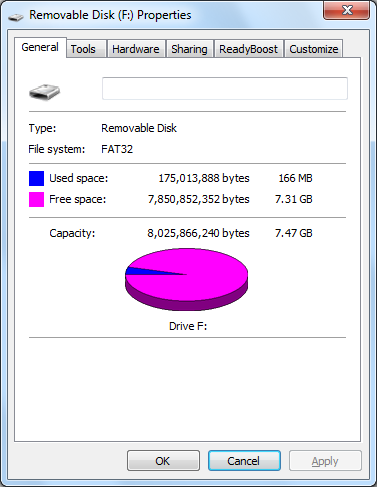
The Ultra Backup comes formatted with FAT32, giving the 8GB model about 7.47GB of usable space. Of that, about 164MB is taken up by the PC and Mac software that comes bundled with the drive.
Software:
While the original Ultra Backup came with software that only ran on SanDisk's U3 platform, the new version of the drive includes backup software for both Windows and Mac. Before you can backup your data, you will need to install the software on your computer. To begin, select your language, accept the license agreement and then choose which external storage device you want the software to work with.
 |
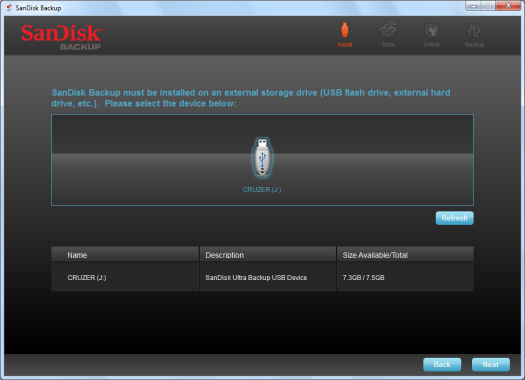 |
The next step is to create a new backup. By default, the software will automatically backup your documents, pictures, videos, music and desktop folders. You can customize this further by selecting specific file types and folders you want to back up. The data can also be protected by a password and software-based encryption.

The software also works with Dmailer's online backup service. The service lets you store up to 2GB for free. If you need more, you can buy another 30GB of storage for $34.99 a year or an unlimited amount of storage space for $69.99.
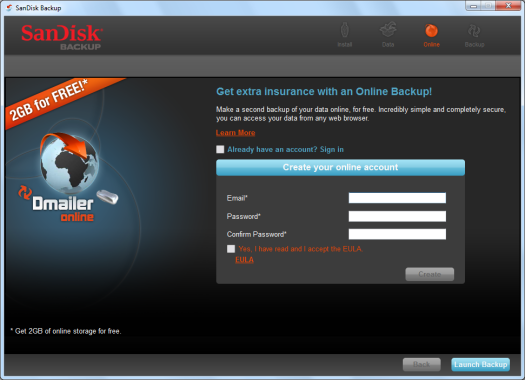 |
 |
Once the software is installed and configured, the Ultra Backup is ready to use. Backups can be started using the backup button on the drive or through the software's main interface. You can also check the status of your local and online backups and view the files on the drive.
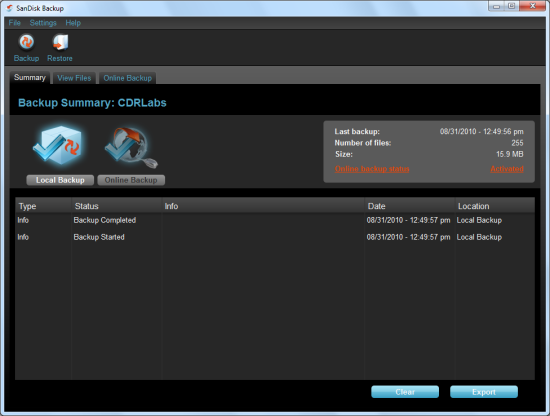
Using the software, you can go in and change your drive's backup settings. You can select which folders to backup as well as the file types. It also lets you filter by size and date and limit the number of versions to keep.
Restoring your data is pretty straight forward. Simply select which files and folders you want to restore and specify the location where you want them copied.
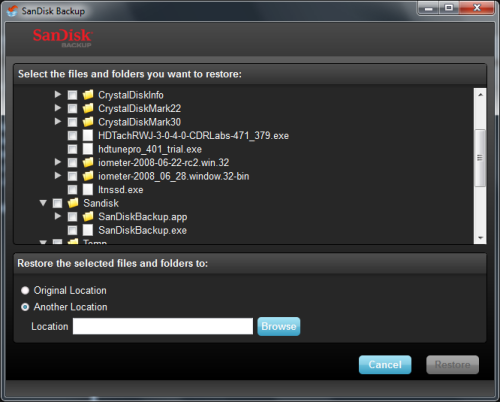
My only real complaint about SanDisk's new backup software is that it doesn't take advantage of the Ultra Backup's hardware-based AES encryption. This was one of the nice things about the U3 platform and seems to have gotten lost in the mix. Of course, the software based encryption does a pretty good job of protecting your data and, if you really want to, you can go back and install U3 on the new drive.
Along the same lines, you can install the new standalone backup software on existing Ultra Backup drives. The Windows and Mac OS X software is freely available and can be downloaded from SanDisk's support website.
The test system used in this review was an HP dc7900. The computer came equipped with an Intel Core 2 Duo E8400 3.0GHz CPU, 2GB of DDR2 800MHz memory, Seagate Barracuda 7200.10 ST3250310AS 250GB SATA hard drive, NVIDIA Quadro FX570 256MB PCIe graphics card and Intel 82567LM-3 gigabit network card. For the operating system, I installed a fresh copy of Windows 7 Enterprise.
To test the performance of the SanDisk Ultra Backup, I ran a series of benchmarks using CrystalDiskMark 3.0, HD Tach RW 3.0.4.0, ATTO Disk Benchmark 2.43 and SiSoftware Sandra Lite 2010.SP2. To get a feel for the "real world" performance, I also copied and pasted 500MB of random files and directories in Windows Explorer.
CrystalDiskMark 3.0:
First, I ran a few quick tests using CrystalDiskMark. This benchmark tool measures the performance of a storage device by testing its sequential read and write speeds as well as its random read and write speeds using blocks 512K and 4K in size.

SanDisk doesn't really say what kind of speeds the Ultra Backup is capable of. Using CrystalDiskMark we can see that the drive is able to read at nearly 21 MB/s and write at 12 MB/s.
HD Tach RW 3.0.4.0:
Next, I used HD Tach to test the Ultra Backup's read, write and burst speeds as well as its seek times and CPU usage.

The performance here was very similar to what we saw with CrystalDiskMark. Looking at the screenshot above, you can see that the Ultra Backup had average read and write speeds of 20.0 MB/s and 12.4 MB/s, respectively, as well as a burst speed of 21.0 MB/s.
ATTO Disk Benchmark 2.43:
I also used ATTO Disk Benchmark to test the Ultra Backup's sequential read and write speeds. The test was run using blocks ranging in size from 0.5KB to 8192KB and the total length set to 256MB.
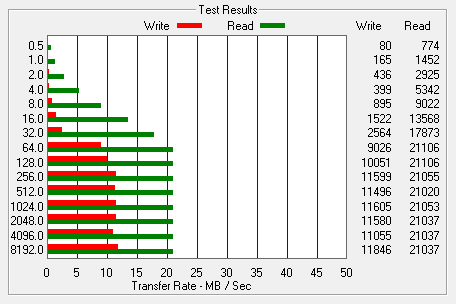
When tested with ATTO, the Ultra Backup topped out at 21.1 MB/s when reading and 11.8 MB/s when writing.
SiSoft Sandra File System Benchmark:
While I am not a big fan of SiSoftware Sandra's optical drive benchmarks, it is a great tool if you want to test a system's performance quickly and easily. One of Sandra's more useful tests is the File System benchmark. This benchmark gives each drive an overall score, or "Drive Index," based on the results of its read and write tests.
| SanDisk Ultra Backup |
Kingston DT Locker+ |
SanDisk Cruzer Enterprise |
Kingston DT 150 |
|
| Drive Index: | 17.60 MB/s | 18.55 MB/s | 22.63 MB/s | 28.36 MB/s |
| Buffered Read: | 20.48 MB/s | 21.10 MB/s | 24.62 MB/s | 31.54 MB/s |
| Sequential Read: | 20.00 MB/s | 22.23 MB/s | 24.69 MB/s | 32.46 MB/s |
| Random Read: | 20.00 MB/s | 22.00 MB/s | 24.68 MB/s | 32.42 MB/s |
| Buffered Write: | 895 kB/s | 2.30 MB/s | 5.21 MB/s | 235 kB/s |
| Sequential Write: | 11.26 MB/s | 6.00 MB/s | 19.38 MB/s | 17.32 MB/s |
| Random Write: | 2.30 MB/s | 1.70 MB/s | 6.99 MB/s | 4.04 MB/s |
SiSoftware Sandra Removable Storage/Flash Devices Benchmark:
Designed with removable storage and flash devices in mind, this benchmark tests a drive's read, write and delete performance using six different file sizes (512 Bytes, 32kB, 256kB, 2MB, 64MB and 256MB). The results are then given in both operations per minute and the corresponding net transfer rate in kB/second. This benchmark also computes an "Endurance Factor," representing the wear and life expectancy of flash devices.
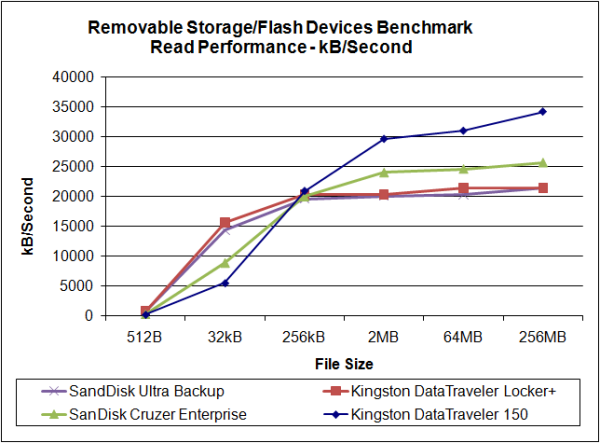
| SanDisk Ultra Backup |
Kingston DT Locker+ |
SanDisk Cruzer Enterprise |
Kingston DT 150 |
|
| 512B Read: | 806 kB/s | 811 kB/s | 248 kB/s | 146 kB/s |
| 32kB Read: | 14280 kB/s | 15560 kB/s | 8820 kB/s | 5430 kB/s |
| 256kB Read: | 19520 kB/s | 20270 kB/s | 19890 kB/s | 20870 kB/s |
| 2MB Read: | 20000 kB/s | 20270 kB/s | 23930 kB/s | 29570 kB/s |
| 64MB Read: | 20270 kB/s | 21330 kB/s | 24530 kB/s | 30930 kB/s |
| 256MB Read: | 21330 kB/s | 21330 kB/s | 25600 kB/s | 34130 kB/s |
While the Ultra Backup performed very well when reading 512B, 32kB and 256kB files, it wasn't able to keep up with SanDisk Cruzer Enterprise nor the Kingston DataTraveler 150 when reading larger files.

| SanDisk Ultra Backup |
Kingston DT Locker+ |
SanDisk Cruzer Enterprise |
Kingston DT 150 |
|
| 512B Write: | 45 kB/s | 14 kB/s | 42 kB/s | 10 kB/s |
| 32kB Write: | 1250 kB/s | 860 kB/s | 2710 kB/s | 547 kB/s |
| 256kB Write: | 5570 kB/s | 3000 kB/s | 10270 kB/s | 4030 kB/s |
| 2MB Write: | 3370 kB/s | 2770 kB/s | 13900 kB/s | 8100 kB/s |
| 64MB Write: | 9600 kB/s | 5330 kB/s | 19200 kB/s | 16000 kB/s |
| 256MB Write: | 8530 kB/s | 4270 kB/s | 21330 kB/s | 17070 kB/s |
Here too the Ultra Backup yielded some mixed performance. While the drive was relatively quick when writing small files, it lagged well behind the SanDisk Cruzer Enterprise and Kingston DataTraveler 150 when writing files 2MB and larger.
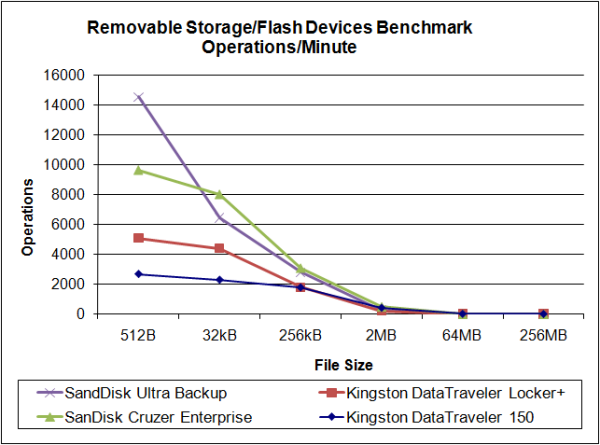
| SanDisk Ultra Backup |
Kingston DT Locker+ |
SanDisk Cruzer Enterprise |
Kingston DT 150 |
|
| Combined Index: | 4828 | 3486 | 5979 | 1940 |
| 512B Files Test: | 14547 | 5083 | 9656 | 2691 |
| 32kB Files Test: | 6451 | 4404 | 8026 | 2304 |
| 256kB Files Test: | 2802 | 1802 | 3095 | 1789 |
| 2MB Files Test: | 251 | 216 | 503 | 427 |
| 64MB Files Test: | 15 | 11 | 18 | 20 |
| 256MB Files Test: | 4 | 3 | 5 | 5 |
As I mentioned above, Sandra also expresses performance in operations per minute. To keep things simple, I've limited the results to the combined index and the total number of read/write/delete operations for each file size.
| SanDisk Ultra Backup |
Kingston DT Locker+ |
SanDisk Cruzer Enterprise |
Kingston DT 150 |
|
| Endurance Factor: | 64.30 | 2.20 | 8.60 | 15.00 |
The Endurance Factor represents the wear and life expectancy of a flash device. According to SiSoft, this number is computed by "dividing the average performance (normal condition, i.e. sequential write) to the lowest performance (high-stress condition, i.e. same block re-write)."
"Real World" Benchmark:
To test the "real world" performance of SanDisk's new flash drive, I copied and pasted 500 MB worth of randomly generated files and directories. All of the files are between 10 bytes and 32MB in size and no more than four directories deep.
| SanDisk Ultra Backup |
Kingston DT Locker+ |
SanDisk Cruzer Enterprise |
Kingston DT 150 |
|
| Write: | 3:22 | 2:50 | 1:02 | 2:31 |
| Read: | 32 seconds | 31 seconds | 31 seconds | 15 seconds |
The Ultra Backup had no problems holding its own when reading. For whatever reason though, the drive took more than three minutes to write our test data.
Final Thoughts:
The SanDisk Ultra Backup is an great choice for anyone looking for a complete, yet easy to use backup solution that can be used at home or on the road. While some may consider the drive's backup button to be a bit of a gimmick, it greatly simplifies the backup process. Just plug the Ultra Backup into your computer, push the button and, as long as the necessary software is installed, your files are automatically copied onto the drive. The new software included with the drive is also easy to configure and supports things like software encryption and Dmaler's online backup service. Best of all, its available for both Windows and Mac OS X. As far as performance goes though, the Ultra Backup is not one of the faster USB flash drives on the market today. Nevertheless, its read and write speeds are more than sufficient for doing backups.
The Ultra Backup is available now in 8GB, 16GB, 32GB and 64GB capacities. Suggested retail prices range from $49.99 to $277.99 depending on the size. However, the drive can be picked up for considerably less from Amazon or through some of the vendors on PriceGrabber.
Highs:
- Backup at the touch of a button
- Available in capacities up to 64GB
- Smaller than hard drive based backup solutions
- Supports hardware and software based encryption
- Backup software compatible with Windows 2000/XP/Vista/7 and Mac OS X
- Nice looking design with amber LED
- USB connector protected by sliding mechanism
- Five year warranty
Lows:
- Backup software does not take advantage of hardware encryption
- Mediocre read and write speeds
- Includes only 2GB of online storage
- Pricey
